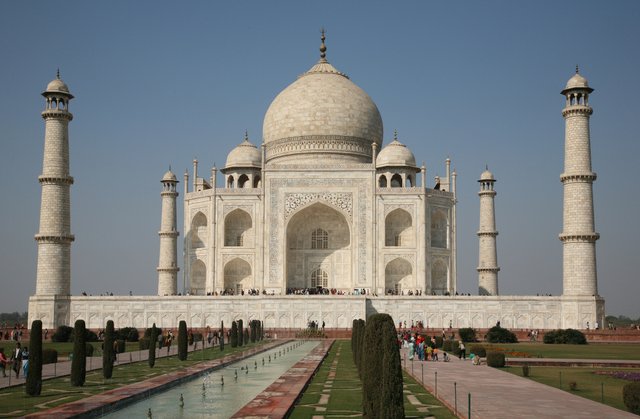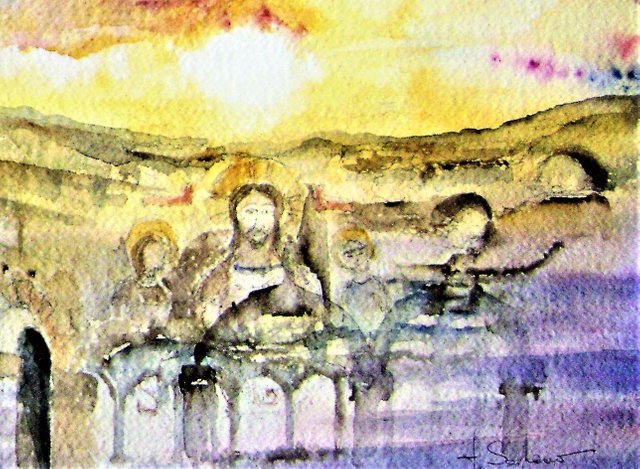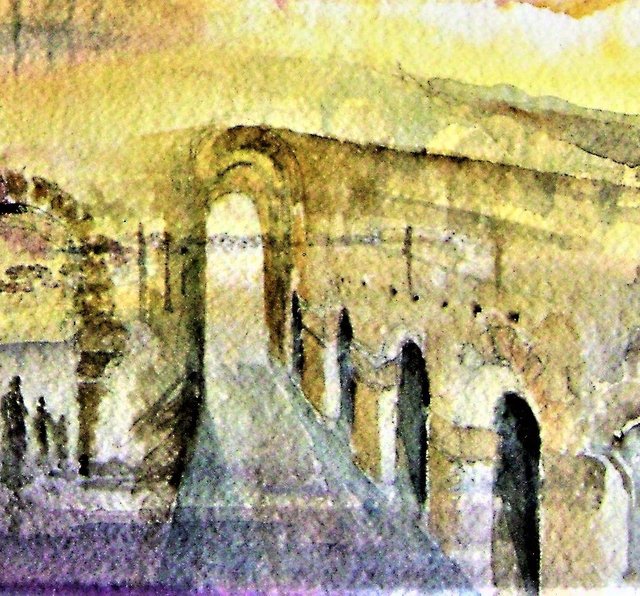Fragments of history - watercolor /// Frammenti di storia - acquarello

Fragments of history

2 0 1 9
watercolor on paper

[ENG]
Fragments of history
Hello dear friends.
We know how the history of the arts is linked to religion and religion.
Man from the very first forms of artistic expression has attempted to represent and honor the divine.
Often the gods coincide with the forms of nature, from which they are born or take shape.
Theogony tells us how the immortal gods are born.
The greatest storytellers of these sublime tales are Hesiod, Homer and Museum.
The genealogy of a god always coincides with the history of humanity and its creations for it.
In this case, men have always dedicated their artistic expressions to the gods.

pyramids area in Cairo - Egypt.
The temples and other gigantic buildings of the great civilizations: Egyptian, Babylonian, Greek, Etruscan, Roman, Maya and others represent the human will to reach the gods.
Desire expressed by the principle of history, the birth of myths and ritual.

the Acropolis with the Parthenon in Athens.
From the Middle Ages, buildings will be built for the rite in the East and the West: basilicas, churches, mosques, synagogues and other buildings for religious cults.

The Taj Mahal mausoleum located in Agra, northern India
In my watercolor that I present to you today, the central theme is the Roman building that fragments into other more modern ones.
A mnemonic research that I reproduced in the pictorial work.

detail
The central theme of my watercolor is the evolution of ancient Roman structures into architectural forms of religious -Christian order.

detail
The birth of the great civil and military architecture, typical of the Romans, evolves and transforms into places of welcome for Christian rites.

detail
A slow and inexorable transformation that, through the aesthetic canons of the Renaissance will be the highest forms of architectural art ever made by man.
In honor of the gods.
Only with the contemporary period, from the 19th century onwards, will architecture be broken by dogmas and religious ties.
Modernism will slowly assert itself, the function of which will be increasingly directed at the enjoyment of the individual and less and less in honor of a god.
I hope I've interested you and that you like my watercolor.
A hug removed from rites and religiosity.
Armando
STEEM ON!!!

[ITA]
Frammenti di storia
Ciao cari amici.
Sappiamo come la storia delle arti sia legata a doppio filo con il culto e le religioni.
L'uomo fin dalle prime forme di espressione artistica ha tentato di rappresentare e di onorare il divino.
Spesso gli dei coincidono con le forme della natura, dalle quali nascono o prendono forma.
La Teogonia ci racconta in che modo gli dei immortali nascono.
I più grandi narratori di questi racconti sublimi sono Esiodo, Omero e Museo.
La genealogia di un dio coincide sempre con la storia dell'umanità e le sue creazioni per esso.
Nella fattispecie gli uomini hanno sempre dedicato le loro espressioni artistiche agli dei.
I templii e altre costruzioni gigantesche delle grandi civiltà: Egiziana, Babilonese, Greca, Etrusca, Romana, Maya e altre rappresentano la volontà umana di arrivare agli dei.
Desiderio espresso dal principio della Storia, dalla nascita dei Miti e della ritualità.
A partire dal medioevo saranno edificate costruzioni per il rito in Oriente e in Occidente: basiliche, chiese, moschee, sinagoghe e altre costruzioni per i culti religiosi.
Nel mio acquarello che vi presento oggi, il tema centrale sono le edificazioni romane che si frammentano in altre più moderne.
Una ricerca mnemonica che ho riprodotto nel lavoro pittorico.
Il tema centrale del mio acquarello è l'evoluzione delle strutture romane antiche in forme architettoniche di ordine religioso - cristiano.
La nascita della grande architettura civile e militare, tipica dei romani, evolve e si trasforma in luoghi di accoglienza per i riti cristiani.
Una lenta e inesorabile trasformazione che, attraverso i canoni estetici del rinascimento sfocierà nelle più alte forme di arte architettonica mai realizzate dall'uomo.
In onore delle deità.
Soltanto con il periodo contemporaneo, a partire dal 19° secolo l'architettura si affrancherà da dogmi e legacci religiosi.
Si affermerà lentamente il modernismo, la cui funzione sarà sempre più rivolta ad una fruizione dell'individuo e sempre meno in onore di un dio.
Spero di avervi interessato e che il mio acquarello vi piaccia.
Un abbraccio avulso da riti e religiosità.
Armando
STEEM ON!!!



Art teacher
Curator of cultural activities
Artistic director and President of the Cultural Association "I Colori della Vita"
https://www.icoloridellavita.life/
and "Fuori Controllo" Festival
https://www.facebook.com/fuoricontrollofestival/




trovo i colori molto particolari...non presenti di solito negli acquerelli....non trovo il termine giusto per definirli...bellissimi
How can you get this color? Only watercolored? Historically, there is a color unknown not painted. Your work catches that color ~ Unexplainable mood you have ~ Fantastic ~
Thank you so much dear friend for your nice comment.
Posted using Partiko Android
This post was shared in the Curation Collective Discord community for curators, and upvoted and resteemed by the @c-squared community account after manual review.
@c-squared runs a community witness. Please consider using one of your witness votes on us here
Dear @armandosodano,
you received an automatic upvote, because I believe in you and I love what you create! 😉
A huge hug from @amico! 🤗
#sbi-skip !trdo & !giphy okay
// Supported by witness untersatz! //
Congratulations @amico, you are successfuly trended the post that shared by @armandosodano!
@armandosodano got 0.21177000 TRDO & @amico got 0.14118000 TRDO!
"Call TRDO, Your Comment Worth Something!"
To view or trade TRDO go to steem-engine.com
Join TRDO Discord Channel or Join TRDO Web Site
Hi @armandosodano, your post has been upvoted by @bdcommunity courtesy of @priyanarc!
Support us by setting us as your witness proxy or delegating STEEM POWER.
JOIN US ON